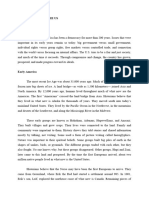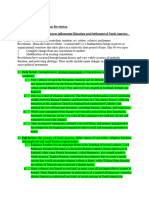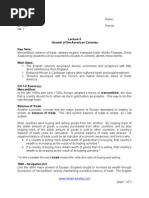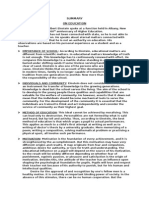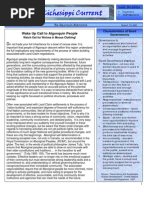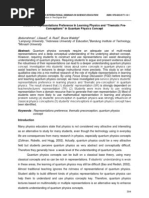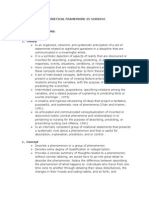0 ratings0% found this document useful (0 votes)
205 viewsChapter 3 Summary
Chapter 3 Summary
Uploaded by
api-264004260Copyright:
© All Rights Reserved
Available Formats
Download as PDF, TXT or read online from Scribd
Chapter 3 Summary
Chapter 3 Summary
Uploaded by
api-2640042600 ratings0% found this document useful (0 votes)
205 views2 pagesOriginal Title
chapter 3 summary
Copyright
© © All Rights Reserved
Available Formats
PDF, TXT or read online from Scribd
Share this document
Did you find this document useful?
Is this content inappropriate?
Copyright:
© All Rights Reserved
Available Formats
Download as PDF, TXT or read online from Scribd
Download as pdf or txt
0 ratings0% found this document useful (0 votes)
205 views2 pagesChapter 3 Summary
Chapter 3 Summary
Uploaded by
api-264004260Copyright:
© All Rights Reserved
Available Formats
Download as PDF, TXT or read online from Scribd
Download as pdf or txt
You are on page 1of 2
NAME _______________________________________ CLASS ______________ DATE __________
Chapter Summary netw rks
The American Colonies and Their Government
Lesson 1 Influences on American Colonial
Government
The worlds first democratic society was formed in ancient
Greece in 400 B.C., although the origins of democracy can be
traced back to ideas in ancient Judaism.
The ancient Greeks created a direct democracy where the
people governed themselves. The ancient Romans created
the first republic, where the people chose leaders to
govern them.
In 1215, English nobles made King John sign the Magna
Carta, a document limiting the kings powers. By the late
1300s, a lawmaking body called Parliament had been
formed.
In 1688 Parliament transferred power from King James II to
Mary and William in what is called the Glorious Revolution.
Mary and William signed the English Bill of Rights,
guaranteeing rights to English citizens.
Enlightenment thinkers spread the idea that all people have
natural rights to life, to freedom, to property ownership, and
to choice of religion. These thinkers also said a social contract
obligated governments to serve and protect the people.
Beginning in 1619, the Jamestown settlers were allowed to
elect leaders to a House of Burgesses, the first
representative democracy in colonial America.
The Pilgrims at Plymouth established the first direct
democracy in North America in the Mayflower Compact.
Copyright The McGraw-Hill Companies, Inc.
Lesson 2 Settlement, Culture, and Government of
the Colonies
Colonists from England, Scotland, Wales, and other parts of
Europe came to America seeking adventure, gold, a chance
to earn a living, and/or religious freedom.
Over time, thousands of Africans were brought to the
colonies against their will to work for the European settlers.
Climate and geography shaped the colonies into three
economic regions: the New England Colonies, the Middle
Colonies, and the Southern Colonies.
1
NAME _______________________________________ CLASS ______________ DATE __________
Chapter Summary netw rks
The American Colonies and Their Government
Lesson 2 Settlement, Culture, and Government of
the Colonies, Cont.
New England had a cold climate and rocky terrain, so farms
were small. Most people lived and worked in towns.
Shipbuilding, fishing, and fur trading were important
industries.
In the Middle Colonies the soil was fertile, so farmers raised
wheat and other cash crops for sale.
The Southern Colonies warm climate and fertile soil led to
the creation of plantations worked by enslaved Africans
Over time, England appointed governors in many colonies
who protected British interests over those of the colonists.
Many colonists resented this.
Lesson 3 Disagreements with Great Britain
Beginning in 1740, the Great Awakening urged people to
build a direct relationship with God and to challenge
traditional religious authority. With the Enlightenment, this
created a spirit of personal freedom in the colonies.
In the 1700s, English colonists moved west into areas
claimed by France. In 1763, Britain defeated France in the
French and Indian War and took over French lands.
To pay off its war debts, the British government imposed
taxes on the colonists. Colonists protested and boycotted,
Copyright The McGraw-Hill Companies, Inc.
with acts such as the Boston Tea Party (1773).
In 1774, representatives from the colonies met at the First
Continental Congress. The king responded to their requests
and boycotts by threatening stronger measures.
In 1775, the Second Continental Congress voted for
independence and Thomas Jefferson wrote the Declaration
of Independence. This was the first document to call for a
government based on the consent of the governed and has
become a model for other nations.
You might also like
- Why Were The British Successful in Colonizing AmericaDocument6 pagesWhy Were The British Successful in Colonizing AmericaEvaKjurcijevskaNo ratings yet
- Substance and MixtureDocument10 pagesSubstance and MixtureJoelmarMondonedoNo ratings yet
- Miracle Man Method Blueprint by Aaron Fisher PDFDocument18 pagesMiracle Man Method Blueprint by Aaron Fisher PDFJose Alejandro Salazar Gandolfo0% (1)
- Who Is George PinckingillDocument20 pagesWho Is George PinckingillDaniele Szoke100% (5)
- The American War of Independence 1776Document17 pagesThe American War of Independence 1776Tejasvi Nandagopal RaoNo ratings yet
- 13 ColoniesDocument3 pages13 ColoniesShirley EstradaNo ratings yet
- Lecture 2 UsaDocument99 pagesLecture 2 UsaZeenat IshfaqNo ratings yet
- USA history presentationDocument36 pagesUSA history presentationKhalid Ur RehmanNo ratings yet
- AMH2010 Final Exam Study NotesDocument11 pagesAMH2010 Final Exam Study NotesChristineNo ratings yet
- Chapter 3 - Cornell NotesDocument5 pagesChapter 3 - Cornell Notesaline lima 78No ratings yet
- The Growth of Nationalism AssignmentDocument10 pagesThe Growth of Nationalism AssignmentPalakNo ratings yet
- American Revolution & AcwDocument11 pagesAmerican Revolution & Acwdreamgirlrr25No ratings yet
- Birth of The American Re Public: Unit 4 Section 4Document11 pagesBirth of The American Re Public: Unit 4 Section 4Ivana ZivkovicNo ratings yet
- World History Lecture 2 American War of Independence Lyst2323Document9 pagesWorld History Lecture 2 American War of Independence Lyst2323Deepak ShahNo ratings yet
- History: Würzburger Dolmetscherschule 2020/2021 Fachakademie II Student Version Landeskunde USADocument23 pagesHistory: Würzburger Dolmetscherschule 2020/2021 Fachakademie II Student Version Landeskunde USAKatja HammerbeckNo ratings yet
- American RevolutionDocument6 pagesAmerican Revolution1518amannammuNo ratings yet
- American History 1600s - 1800sDocument56 pagesAmerican History 1600s - 1800sTerézia AnettováNo ratings yet
- American History: Early Settlements, The Pilgrims and The American RevolutionDocument3 pagesAmerican History: Early Settlements, The Pilgrims and The American RevolutionSanja ŽarkovićNo ratings yet
- Material 658E63F0Document31 pagesMaterial 658E63F0MaryamNo ratings yet
- World History 04 - Daily Class Notes - UPSC Prahar (Hinglish)Document3 pagesWorld History 04 - Daily Class Notes - UPSC Prahar (Hinglish)lalitkumar.jeenurajputNo ratings yet
- 13 Colonies The Colonies Come of AgeDocument24 pages13 Colonies The Colonies Come of AgeRyan HoganNo ratings yet
- Lesson 4Document27 pagesLesson 4api-264216738No ratings yet
- Chapter 1 - The Colonial Period (1607-1776) - Expanded NotesDocument3 pagesChapter 1 - The Colonial Period (1607-1776) - Expanded Notes84883310No ratings yet
- American History: Week 3. The Founding of The U.SDocument26 pagesAmerican History: Week 3. The Founding of The U.S김도비No ratings yet
- 13 British ColoniesDocument46 pages13 British ColoniesSarah SunNo ratings yet
- North America: 590 Million People Living On The Continent Countries in North AmericaDocument7 pagesNorth America: 590 Million People Living On The Continent Countries in North AmericaLeilalyn NicolasNo ratings yet
- Chapter 22 Patterns of Nation-States and Culture in The Atlantic World For StudentsDocument18 pagesChapter 22 Patterns of Nation-States and Culture in The Atlantic World For StudentsNiara ChaneyNo ratings yet
- American War - of IndependenceDocument12 pagesAmerican War - of Independencespereira186No ratings yet
- 2.1 American RevolutionDocument4 pages2.1 American RevolutionJosh CissellNo ratings yet
- BA Cult Final NotesDocument18 pagesBA Cult Final Notesesmabahadiir84No ratings yet
- CCL With Miss AmraouiDocument15 pagesCCL With Miss AmraouiSlimane HoudjedjeNo ratings yet
- Uk Us Culture Session8 PDFDocument22 pagesUk Us Culture Session8 PDFHAYAT HACHIMINo ratings yet
- 3 Colonial Life COVIDDocument24 pages3 Colonial Life COVIDAllison HoyleNo ratings yet
- The History of The Us - Lesson 1 Week 5Document18 pagesThe History of The Us - Lesson 1 Week 5ellidrissimohamed2005No ratings yet
- Thirteen Colonies and English Empire Amsco ch2Document16 pagesThirteen Colonies and English Empire Amsco ch2ftacct5No ratings yet
- History of USADocument107 pagesHistory of USAZeenat IshfaqNo ratings yet
- American War of Independence 1Document10 pagesAmerican War of Independence 1techmastersupreethNo ratings yet
- OboiDocument6 pagesOboiVera WuNo ratings yet
- Life in The ColoniesDocument43 pagesLife in The ColoniesurmomNo ratings yet
- Sample American Revolution WorksheetsDocument12 pagesSample American Revolution WorksheetsDebbie Walters Colla100% (1)
- Us Uk History and Culture 2 RemovedDocument24 pagesUs Uk History and Culture 2 Removedilyassmaghraoui94No ratings yet
- HandoutDocument3 pagesHandoutSebastiaan BentNo ratings yet
- Exam 2 CH 4-7pdfDocument1 pageExam 2 CH 4-7pdfandrewstine99No ratings yet
- 6_The colonial experiences by mark CanadaDocument5 pages6_The colonial experiences by mark CanadashilihanineNo ratings yet
- APUSH Chapter 5 SummaryDocument4 pagesAPUSH Chapter 5 SummaryJohn YellerNo ratings yet
- Bahamas Bgcse History CourseworkDocument4 pagesBahamas Bgcse History Courseworkf5dct2q8100% (2)
- Assignment I UsDocument9 pagesAssignment I UsUrvashi ChandranNo ratings yet
- La Era de las Revoluciones (1770-1871)Document16 pagesLa Era de las Revoluciones (1770-1871)elbarnaouidemnatiNo ratings yet
- The Americans 3.2 - PG 120 - 129Document9 pagesThe Americans 3.2 - PG 120 - 129Joe BradleyNo ratings yet
- United States History and Government Regents Review PacketDocument30 pagesUnited States History and Government Regents Review PacketJuliAnn Immordino100% (1)
- US Summary First SemesterDocument16 pagesUS Summary First Semesterfahemni.tnNo ratings yet
- History, U.S. Honors - Lecture 3 - Growth of The American ColoniesDocument3 pagesHistory, U.S. Honors - Lecture 3 - Growth of The American ColoniesMarty IrwinNo ratings yet
- American SymbolsDocument5 pagesAmerican SymbolsCherubin WeronikaNo ratings yet
- US HISTORY+Colonial RegimeDocument37 pagesUS HISTORY+Colonial RegimeElena Garcia-PaullierNo ratings yet
- American Revolution War 075810Document5 pagesAmerican Revolution War 075810Jack saadNo ratings yet
- MYP5 Unit-1 Notes British Empire BuildingDocument10 pagesMYP5 Unit-1 Notes British Empire Buildingruturajsatav4141No ratings yet
- US History Packet 09-10Document224 pagesUS History Packet 09-10Hunter Quinn Simons0% (1)
- HISTORIA TEMA 2Document43 pagesHISTORIA TEMA 2eupro134No ratings yet
- Spain (Spanish) 2. France (French) 3. England (Bri8sh) 4. Netherlands (Dutch)Document67 pagesSpain (Spanish) 2. France (French) 3. England (Bri8sh) 4. Netherlands (Dutch)rose_eppensteinerNo ratings yet
- Wed Sept 20 American HistoryDocument18 pagesWed Sept 20 American Historyapi-367886489No ratings yet
- Period 3 Reading Guide (Ch. 4-6)Document5 pagesPeriod 3 Reading Guide (Ch. 4-6)karllyg80No ratings yet
- For Life and Liberty: Causes and Effects of the Declaration of IndependenceFrom EverandFor Life and Liberty: Causes and Effects of the Declaration of IndependenceNo ratings yet
- Chapter 13 State Governments SummaryDocument3 pagesChapter 13 State Governments Summaryapi-264004260No ratings yet
- Chapter 6 SummaryDocument2 pagesChapter 6 Summaryapi-264004260No ratings yet
- Chapter 6 SummaryDocument2 pagesChapter 6 Summaryapi-264004260No ratings yet
- Judicial Branch Content ReviewDocument3 pagesJudicial Branch Content Reviewapi-264004260No ratings yet
- Chapter 3 SummaryDocument2 pagesChapter 3 Summaryapi-264004260No ratings yet
- HobbeslockemontesquieuDocument3 pagesHobbeslockemontesquieuapi-264004260No ratings yet
- Syllabus 7th GradeDocument2 pagesSyllabus 7th Gradeapi-264004260No ratings yet
- Chapter 3 SummaryDocument3 pagesChapter 3 Summaryapi-264004260No ratings yet
- Chapter 3 SummaryDocument3 pagesChapter 3 Summaryapi-264004260No ratings yet
- SPRD TRS KG Planning All School DurationsDocument6 pagesSPRD TRS KG Planning All School DurationsSrivatsa MadhaliNo ratings yet
- Pragmatics Phonology Semantics: MorphologyDocument9 pagesPragmatics Phonology Semantics: MorphologyGenevieve Guimbongan Siagto100% (1)
- Task Listening SMP 7 Kelas 7Document4 pagesTask Listening SMP 7 Kelas 7Hakim MNo ratings yet
- CGE416 Introduction To Petroleum Technology Special Task: Society of Petroleum Engineers (SPE)Document1 pageCGE416 Introduction To Petroleum Technology Special Task: Society of Petroleum Engineers (SPE)zickmoderatoNo ratings yet
- Accomplishment Report (June-August)Document4 pagesAccomplishment Report (June-August)api-1997021596% (23)
- Project Profile: Water For Women (WFW) Wash and Beyond - Transforming Lives in Eastern IndonesiaDocument4 pagesProject Profile: Water For Women (WFW) Wash and Beyond - Transforming Lives in Eastern IndonesiasilviaanastasialandaNo ratings yet
- The History of Anthropological Theory Anthropology 441Document6 pagesThe History of Anthropological Theory Anthropology 441Panos CayafasNo ratings yet
- Week 1 LectureDocument12 pagesWeek 1 LectureHung LamNo ratings yet
- On Education SummaryDocument2 pagesOn Education SummaryNew one74% (31)
- Gee3 Aber-Ambuyoc LMDocument5 pagesGee3 Aber-Ambuyoc LMynaccessibleNo ratings yet
- Willis Manifesto For EthnographyDocument9 pagesWillis Manifesto For EthnographyLisistrata LusandianaNo ratings yet
- 3 #Strength Stories: STRENGTH 1: Leadership, Responsibility, Helping OthersDocument2 pages3 #Strength Stories: STRENGTH 1: Leadership, Responsibility, Helping OthersMuhammad shahbazNo ratings yet
- What Is SociolinguisticsDocument6 pagesWhat Is SociolinguisticsHayat Alzahrani100% (1)
- Ex-Specialized Architects, Wonderland Manual For Emerging ArchitectsDocument3 pagesEx-Specialized Architects, Wonderland Manual For Emerging ArchitectsliveintransitionNo ratings yet
- Kichesippi Current 1Document9 pagesKichesippi Current 1api-3758586No ratings yet
- Paper Abstract: 2007 Pangasinan ConferenceDocument17 pagesPaper Abstract: 2007 Pangasinan ConferenceSonny Villafania100% (2)
- Figures of Speech - TurlaDocument4 pagesFigures of Speech - TurlaJaydel Ira Dela RosaNo ratings yet
- Importance of Audience Involvement in Technical WritingDocument5 pagesImportance of Audience Involvement in Technical Writing1991sana100% (1)
- New Attendance NSQF Pdtdm&acctdm Jan 19 A3Document48 pagesNew Attendance NSQF Pdtdm&acctdm Jan 19 A3Vt waghmareNo ratings yet
- Why Spinoza Had No AestheticsDocument8 pagesWhy Spinoza Had No AestheticsSuraj VermaNo ratings yet
- Indigenous People in Bislig CityDocument6 pagesIndigenous People in Bislig CityEsclet PHNo ratings yet
- Gs 12Document11 pagesGs 12ronaessi chhillarNo ratings yet
- The Looting Machine:Warlords, Oligarchs, Corporations, Smugglers, and The Theft of Africa's WealthDocument4 pagesThe Looting Machine:Warlords, Oligarchs, Corporations, Smugglers, and The Theft of Africa's WealthjesusNo ratings yet
- Jurnal 9Document364 pagesJurnal 9Dimas Satriadi100% (3)
- Moral Theory (Louden)Document245 pagesMoral Theory (Louden)Mario Perez100% (1)
- Theoretical Framework in NursingDocument35 pagesTheoretical Framework in Nursinglen0593% (15)
- Historical Dictionary of Lesbian Literature PDFDocument295 pagesHistorical Dictionary of Lesbian Literature PDFRafael Garou100% (11)





























